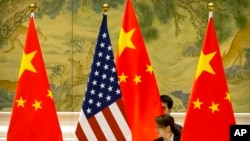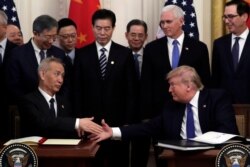Chinese investment in the U.S. in 2019 dropped to its lowest level in a decade, a new report estimates, reflecting trade tensions between the world's top two economies even before the coronavirus pandemic took hold.
The U.S.-China "Phase One" trade agreement had paved the way for more investment this year, but the COVID-19 pandemic has changed that outlook, said the report released Monday by the independent Rhodium Group and the National Committee on United States-China Relations.
In the past year, Chinese direct investment has been flowing to the U.S. on average of about $2 billion every three months. The group said that figure plummeted to $200 million in the first quarter of 2020, which is almost a complete halt. A recovery is likely in the second half of the year, but the full-year numbers are expected to show the impact of the coronavirus pandemic.
Also during the past three months, U.S. firms announced $2.3 billion in new direct investment projects in China. That is down slightly compared to a quarterly average of $2.8 billion in 2019. The report said that so far, most U.S. businesses in China have not made major changes to their operations there.
The COVID-19 pandemic led to the exposure of the vulnerability of the global supply chain, which could lead U.S. companies to move more manufacturing capacity out of China. But at the same time, localization of operations could lead to more investment, according to the report.
Venture capital saw a steep drop in 2019 as China's overheated technology market corrected sharply and U.S. regulators were given the mandate to scrutinize early-stage high-tech deals.
The trajectory of broader bilateral relations remains important: Coming off the "Phase One" agreement, the COVID-19 crisis presented an opportunity for the U.S. and China to work together on crisis mitigation and scientific solutions to end the virus spread, said the report.
However, it warned that intensifying economic competition and a systemic battle of political systems continue to weigh on the relationship as governments blame each other for their struggles.
"Our two countries are still far from decoupled, but the trend lines are not pointing in the right direction," Stephen A. Orlins, president of the National Committee on United States-China Relations, said in a statement.

